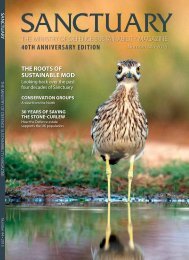SUSTAINABILITY
UC30G
UC30G
You also want an ePaper? Increase the reach of your titles
YUMPU automatically turns print PDFs into web optimized ePapers that Google loves.
FEATURES<br />
Managing the historic environment<br />
on the Defence estate in Wales<br />
significance. Only a small number of<br />
ancient monuments (37) and historic<br />
buildings (7) are legally protected;<br />
Cadw, the Welsh Government’s historic<br />
environment service’s designation<br />
programme will increase this number<br />
over time.<br />
Brownslade barrow skeleton excavation © Crown<br />
A key difference between historic and<br />
natural environment concerns is that<br />
archaeological remains are a finite and<br />
non-renewable resource, which in<br />
many cases are highly fragile and<br />
vulnerable to damage and destruction.<br />
Unlike many aspects of the natural<br />
environment, archaeological sites<br />
cannot recover; once they have been<br />
destroyed, the archaeological<br />
information has gone and cannot be<br />
retrieved or re-constituted.<br />
The UK Defence estate is enormously<br />
rich in historic and natural environment<br />
assets. Shaped by the activities of past<br />
generations, the people of Wales have<br />
inherited a unique and constantly<br />
encountered historic environment that<br />
contributes to a sense of place and<br />
helps to define Wales as a nation. The<br />
importance and added value of this<br />
heritage continues to be recognised,<br />
managed and appreciated by the<br />
Ministry of Defence.<br />
As of 2014 the UK Defence estate<br />
comprised 228,000ha of land and<br />
foreshore and the MOD held rights<br />
over a further 204,900ha. In total this<br />
represents 1.8% of the UK land mass.<br />
Approximately 19,070ha of this land is<br />
located in Wales.<br />
and training areas. Typically this is<br />
undeveloped land that has not been<br />
subjected to intensive agricultural<br />
improvement. Consequently, the<br />
survival, diversity and extent of the<br />
known archaeological remains is of<br />
enhanced archaeological significance<br />
and value.<br />
The Defence estate in Wales<br />
collectively preserves many thousands<br />
of individual historic environment<br />
assets. Individual elements on their<br />
own may seem insignificant, but<br />
collectively they are of great<br />
The typical archaeological site types<br />
of traditional archaeology on the<br />
Defence estate such as Bronze Age<br />
round barrows and Iron Age hillforts<br />
tend to be incredibly well preserved.<br />
The 2004 Sanctuary Award winning<br />
excavation at Brownslade Barrow,<br />
Castlemartin revealed exceptional<br />
funerar y and agricultural evidence.<br />
Protection from development is one<br />
reason for this occurrence, but of<br />
greater importance are the significant<br />
efforts undertaken by the MOD to<br />
proactively monitor and manage<br />
these monuments.<br />
Around a third of the total estate<br />
is classed as ‘built’ and includes<br />
airfields, bases, offces, facilities<br />
and accommodation. Those sites<br />
that have been occupied for a long<br />
duration usually possess a strong<br />
and important military heritage<br />
identity. The remainder comprises<br />
of ‘rural’ estate and includes ranges<br />
Sennybridge Star protecting an Iron Age hill fort © Pete Telfer<br />
34<br />
Sanctuary 44 • 2015



